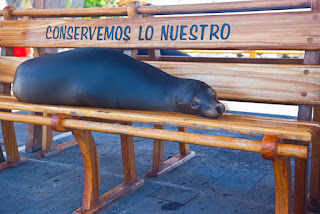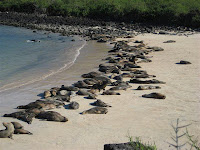 |
| Sea Lion Basking on a Bench in Puerto Baquerizo Moreno |
 |
| Sea Lion Pup |
In physique, sea lion males, like human males, are broader on top and more narrow through their abdomen. Female sea lions are somewhat more slender in general. The males also have a forehead, unlike females and pups, which have flatter heads. All sea lions have a pointy, whiskered nose and a long, narrow muzzle.
 |
| Sea Lion Colony on Gardner Bay |
 |
| Sea Lions Males Playing and Learning to Fight |
Males regularly engage in battles for dominance and challenges occur all the time. It’s almost inevitable that the reigning bull is going to be ousted. After all, he is so committed to protecting his harem that he cannot leave it to feed himself. Thus, over time, the one who was strongest, weakens and another male will eventually be capable of taking over his territory. These challenges can become rather physical, thus the reason for the males' thick necks and torso – this thickness protects them from the physical blows and other battle scars that can occur during a fight for domination.
It's not so terrible to lose the fight though. The once-dominant male gets to go on a much-needed vacation. He joins the other extra males on their own beach front property where they can eat their way back to health and lie around on the beach like couch potatoes! There they live together until they strengthen and take on another challenge.
There are no Seals in the Galapagos - Only Sea Lions of Two Types
But, these endemic sea lions aren't the only marine mammal in the Galapagos Islands. And, because sea lions are unfamiliar creatures, they are often called by the name "seal", a better known and similar looking creature. Here, I am going to tell you about the two types of sea lions in Galapagos and teach you how to distinguish the two types of Galapagos sea lions from seals.
It's inevitable. At the beginning of the week as we start a cruise, my guests refer to sea lions as seals, and I correct them, repeatedly, until the word “sea lion” becomes second nature. I admit, sometimes I threaten a $5.00 fine for each time they use the word seal, but I never collect a dime! There is a legitimate reason for the confusion, because lots of people call the second type "fur seal." But, that is a real misnomer and should be referred to as fur sea lion.
Both types of sea lions are within the order pinnipeds, meaning fin-footed. I am going to discuss the difference between these pinnipeds and “true seals” below. But recognizing that there are great similarities and shared characteristics between the Galapagos sea lions and fur sea lions goes a long way toward explaining the confusion.
But, these endemic sea lions aren't the only marine mammal in the Galapagos Islands. And, because sea lions are unfamiliar creatures, they are often called by the name "seal", a better known and similar looking creature. Here, I am going to tell you about the two types of sea lions in Galapagos and teach you how to distinguish the two types of Galapagos sea lions from seals.
 |
| Fur Sea Lion |
 |
| Sea Lion |
Both types of sea lions are within the order pinnipeds, meaning fin-footed. I am going to discuss the difference between these pinnipeds and “true seals” below. But recognizing that there are great similarities and shared characteristics between the Galapagos sea lions and fur sea lions goes a long way toward explaining the confusion.
Characteristics That Fur Sea Lions and Galapagos Sea Lions Have in Common
- Both have ear flaps and great hearing
- Both have short fur
- Both have fine-tuned whiskers called vibrissae which work as tactile sensors, much like those of a cat
- Both have large, hairless flippers which they use more effectively on land. They are able to rotate their hind flippers toward the ground thus enabling them to walk on all four appendages
- They are both social, although Galapagos sea lions are more so than the fur sea lion
- Both are carnivorous and eat a wide variety of fish, crustaceans and clams
- Both spend time on both the land and in the water.
 |
| Sea Lion Pup |
Characteristics That Differentiate Fur Sea Lions and Galapagos Sea Lions
Still, there are substantial differences between fur seals and sea lions as well. Here they are:
 |
| Fur Sea Lion Pup |
- The Galapagos sea lion has a blunt nose, while the fur sea lion has a pointed nose
- The Galapagos sea lion tends to be unafraid of people, while the fur sea lion may exhibit some signs of fear
- The Galapagos sea lion's hind flippers move independently; those of the fur sea lion are longer and move together
- The Galapagos sea lion has coarser, less dense hair, while the fur sea lion has finer, denser and thicker hair
- The Galapagos sea lion has marked color variation between the sexes, while there is little color variation between the sexes in fur sea lions
- Galapagos sea lions prefer sandy beaches, while fur sea lions prefer rocky shores
- Adult male Galapagos sea lions have a mane of longer hair around their neck and chest, while fur sea lions have no mane
- Galapagos sea lions feed over the continental shelf, while fur sea lions feed at edge of the continental shelf and sometimes even beyond it
- The fur sea lion is the smallest member of this family, while Galapagos sea lions can be very large, up to even 1000 pounds
- The fur sea lion is a better climber
- The fur sea lion's eyes tend to be bigger than those of a Galapagos sea lion; some say it has a sad expression, while a Galapagos sea lion seems to have a smile on its face (see the photo above for the precious smile)
- The fur sea lion’s voice is hoarser and more guttural, but is less often used; the Galapagos sea lion's bark is loud and frequent.
That helps with the distinction between a Galapagos sea lion and a Galapagos fur sea lion, but there are even bigger difference between these sea lions and “true seals," which are not found on the Galapagos Islands.
A Comparison Between Galapagos Sea Lions and "True" Seals
- First of all, let's start with their origins. Sea lions are descendents of wolves; seals are descended from bears.
- True seals do not exist in the Galapagos Islands
- Sea lions have external flaps that look like ears; seals do not, instead they have tiny holes on the sides of their sleek heads; both have excellent hearing skills
- Seals are generally smaller than sea lions
- A major difference is in their flippers: Sea lion flippers are much better adapted to the land than those of the seal.
- The sea lion’s front flippers have a band of fur, but are mostly covered in a leathery skin. They have digits and claws. Their flipper configuration makes sea lions very agile in the water.
- Sea lions also have the ability to control their flippers independently, which helps them in changing direction underwater and gives the greater control when on land. Seals, in contrast, have weaker, furry and stubbly front feet with thinly webbed flippers; their hind flippers don't rotate. They are much smaller than those of the sea lion. They move on land by using these little appendages to wiggle forward, and their movement is sort of caterpillar-like. Their back flippers are, however, stronger and propel them powerfully through the water
- Sea lions are noisy; seals are quieter, vocalizing through soft grunts instead of barks and roars
- There is a difference in a sea lion's and seal's sex organs as well. The seal's penis and testes are internal and their nipples can be retracted to reduce drag, thus making them very aerodynamic in the water
- Seals are less social than their sea-lion cousins. They spend more time in the water than sea lions do and often lead solitary lives in the wild, coming ashore together only once a year to meet and mate.
 |
| Harbor Seal - see lack of external ears, small rear and front flippers |
As we have learned and seen for ourselves, sea lions love to lull around together, playing, cavorting, sun bathing and entertaining themselves and, as very lucky bystanders, us as well.
No comments:
Post a Comment